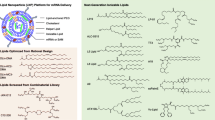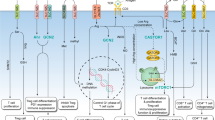Abstract
MUC1 mucins are highly glycosylated glycoproteins expressed on the luminal surfaces of glandular epithelia. In breast and ovarian carcinomas, their expression is frequently upregulated and they may be secreted into the circulation of cancer patients. Early studies aimed at the production of anti-MUC1 monoclonal antibodies revealed that MUC1 was a potent immunogen in mice with many monoclonal antibodies raised defining epitopes within the protein core of MUC1. The immunogenicity of MUC1 has now been extended to human studies and it is apparent that patients with breast and ovarian malignant disease are able to mount immune responses against MUC1. These findings provide information on the mechanisms involved in the recognition of MUC1 expressing tumours. The utilisation of MUC1 related immunogens to stimulate immune responses to tumours could lead to the improved management of patients and the development of new immunotherapeutic strategies aimed at the eradication of MUC1 mucin expressing cancers.
Similar content being viewed by others
References
Barnd DL. Lan MS. Metzgar RS and Finn OJ: Specific, major histocompatibility complex-unresticted recognition of tumorassociated mucins by human cytotoxic T cells. Proc Nat Acad Sci 86:7159–7163, 1989.
Bashford JL. Robins RA and Price MR: Development of an anti-idiotypic antibody reactive with an antibody defining the epitope R P A P in the MUC-1 epithelial mucin core. Int J Cancer 54:778–783, 1993.
Blarathan S. Moriarty J. Moody CE and Sherbom AP: Effect of tumicamycin on sialomucin and natural killer susceptibility of rat mammary tumor ascites cells. Cancer Res 50:5250–5256, 1990.
Burchell J. Taylor-Papadimitriou J. Boshell M. Gendler S and Duhig T: A short sequence within the amino acid tandem repeat of a cancer-associated mucin contains immunodominant epitopes. Int J Cancer 44:691–696, 1989.
Croce MV. Price MR and Segal-Eiras A: Expression of monoclonal antibody-defined antigens in fractions isolated from human breast carcinomas and patients’ serum. Cancer Immunol. Immunother 40:132–137, 1995.
Denton G. Sekowski M and Price MR: Induction of antibody responses to polymorphic epithelial mucins usine synthetic peptide constructs as immunogens. Cancer Lett 70:143–150, 1993.
Denton G. Hudecz F. Kajtar J. Murray A. Tendler SJB and Price MR: Sequential order of T and cell epitopes affects immunogenicity but not antibody recognition of the cell epitope. Peptide Research 7:258–264, 1994.
Gendler S. Spicer Ladani E-N. Duhig T. Peat N. Burchell J. Pemberton L. Boshell M and Taylor-Papadimitirion J: Structure and biology of a carcinoma-associated mucin, MUC1. Amer Rev Respir Dis 144:S42–47, 1991.
Gilead Z. Troy F and Sulitzeanu D: Isolation and electrophoretic analysis of immune complexes from patients with breast cancer. Eur J Cancer Clin Oncol 17:1165–1176, 1981.
Girling A. Bartkova J. Burchell J, Gendler S, Gillet C and Taylor-Papadimitriou J: A core protein epitope of the polymorphic epithelial mucin detected by the monoclonal antibody SM-3 is selectively exposed in a range of primary breast carcinomas. Int J Cancer 43:1072–1076, 1989.
Gourevitch M, Mensdorff-Pouilly SV, Litvinov SV, Verstraeten A, Van Kamp GJ, Kenemans P, Hilgers J: Circulating immune complexes involving polymorphic epithelial mucin might impair CA 15.3 assay results. In: Klapdor R (ed) 7th Hamburg Symposium on Tumour Markers. Abstract p 57. 1993.
Griffiths B. Gordon A. Burchell J. Bramwell ME. Griffiths A. Price MR. Taylor-Papadimitriou J. Zanin D and Swallow DM: The breast tumour-associated epithelial mucins and the peanut lectin binding urinary mucins are coded by a single highly polymorphic gene locus ‘PUM’. Dis. Markers 6:185–194, 1988.
Hayes DF. Silberstein DS. Rodrique SW and Kufe DW: DF3 antigen, a human epithelial cell mucin, inhibits adhesion of eosinophils to antibody-coated targets. J Immunol 145:962–970. 1990.
Herbernan R. Bordes M. Lambert P. Luthra H. Robins RA. Sizaret Ph and Theofilopoulos A: Report on international comparative evaluation of possible value of assays for IC for diagnosis of human breast cancer. Int J Cancer 27:569–576, 1981.
Hinoda Y. Nakagawa N. Nakamua H. Machiguchi I. Itoh F. Adachi M. Yabana T. Imai K and Yachi A: Detection of a circulating antibody against a peptide epitope on a mucin core protein. MUC1. in ulcerative colitis. Immunol Lett 35:163–168, 1993.
Ho SB and Kim YS: Carbohydrate antigens on cancer-associated mucin-like molecules. Semin Cancer Biol 2:389–400, 1992.
Höffken Meredith ID.Robins RA. Baldwin RW. Davics CJ and Blamey RW: Immune complexes and prognosis of human breast cancer. Lancet 1:672–673, 1978.
Hull S. Bright A. Carraway K. Abe M. Hayes D and Kufe D: Oligosaecharide differences in the DF3 sialomucin antigen from normal human milk and the BT20 human breast carcinoma cell line. Cancer Comm 1:261–267, 1989.
Ioannides CG. Fisk B. Jerome KR. Wharton JT and Finn OJ: Cytotoxic T-cells from ovarian malignant tumors can recognise polymorphic epithelial mucin core peptides. J Immunol 151:3693–3703, 1993.
Jerome KR. Barnd DL. Bendt KM. Boyer CM. Taylor-Papadimitriou J. McKenzie IFC. Bast RC and Finn OJ: Cytotoxic Tlymphocytes derived from patients with breast adenocarcinoma recognize an epitope present on the protein core of a mucin molecule preferentially expressed by malignant cells. Cancer Res 51:2908–2916, 1991.
Kennedy RC: The impact of iodiotype based strategies on cancer immunity. Immunol All Clin N Amer 11:425–444, 1991.
Kim YS. Gum JR and Toribara N: The structure of human intestinal mucins. Amer Rev Respir Dis 144:S10–14, 1991.
Kosmas Epenetos AA and Courtney-Luck N: Activation of cellular immunity after intracavity monoclonal antibody therapy of ovarian cancer. Cancer 73:3000–3010, 1994.
Kotera Y. Fontenot D. Pecher G. Metzgar RS and Finn OJ: Humoral immunity against a tandem repeat epitope of human mucin MUC-1 in sera from breast pancreatic and colon cancer patients. Cancer Res 54:2856–2860, 1994.
Ligtenberg MJL. Buijs F. Vos HL and Hilkens J: Suppression of cellular aggregation by high levels of episialin. Cancer Res 52:2318–2324, 1992.
Lotze MT and Finn OJ: In vivo testing of the immune response to human breast, colon and pancreatic tumor mucin. Clinical Protocol in Progress. Pittsburgh Cancer Institute, internal publication. 1994.
Mensdorff-Pouilly SV, Gourevitch M, Verstraeten A, Van Kamp GJ, Kenemans P and Hilgers J: Circulating immune complexes containing polymorphic epithelial mucin (PLM) in benign breast tumor and breast and ovarian cancer patients. In: Klapdor (ed) 7th Hamburg Symposium on Tumour Markers. Abstract p 56, 1993.
Middleton-Price H. Gendler S and Malcolm S: Close linkage of PUM and SPTA within chromsome band Iq2l. Ann Hum Genet 52:273–278, 1988.
Papsidero L. Namoto T. Snyderman M and Chu T: Immune complexes in breast cancer patients as detected by Clq binding. Cancer 44:1636–1640, 1979.
Price MR: High molecular weight epithelial mucins as markers in breast cancer. Eur J Cancer Clin Oncol 24:1799–1804. 1988.
Price MR and Tendler SJB: Polymorphic epithelial mucins molecular characteristics and association with breast cancer. The Breast 2:3–7, 1993.
Price MR. Hudecz F. ’Sullivan Baldwin RW. Edwards PM and Tendler SJB: Structural and immunological features of the protein core of human polymorphic epithelial mucins. Mol Immunol 62:795–803, 1990.
Rughetti A. Turchi V. Ghetti CA. Seambia G. Panici PB. Roncucci G. Mancuso SM. Frati L and Nuti M: Human B-cell immune response to the polymorphic epithelial mucin. Cancer Res 53:2457–2459, 1993.
Sandison AT: The breast. In Muir’s Textbook of Pathology. J R Anderson. Ed Edward Arnold. London. 1976, pp 925–939.
Singhal A and Hakomori S-l: Molecular changes in carbohydrate antigens associated with cancer. Bioessays 12:223–230, 1990.
Stranahan PL. Howard RB. Pfenninger O. Cowen MF. Johnston MR and Pettijohn DE: Mucin gel formed by tumorigenic squamous lung carcinoma cells has Lea-X oligosaecharides and excludes antibodies from underlying cells. Cancer Res 52:2923–2930, 1992.
Swallow DM. Gendler SJ. Griffiths B. Corneu G. TaylorPapadimitriou J and Bramwell M: The human tumour-associated epithelial mucins are coded by an expressed hypervariable gene locus PUM. Nature 327:82–84, 1987.
Fakahashi T. Makiguchi Y. Hinoda Y. Kakiuchi H. Nakagawa N. Imai K and Yachi A: Expression of MUC1 on myeloma cells and induction of HLA-unrestricted CTL against MUC1 from a multiple myeloma patient. J Immunol 153:2102–2109, 1994.
Taylor-Papadimitriou J. Stewart L. Burchell J and Beverley P: The polymorphic epithelial mucin as a target for immunotherapy. Ann N Y Acad Sci 690:69–79, 1993.
Von Kleist S. Bombardieri E. Buraggi G. Gion M. Hertel A. Hor G. Noujaim A. Schwartz M. Senekowitsch R and Wittekind C: Immunodiagnosis of tumours. Eur J Cancer 29A:1622–1629, 1993.
Zotter S. Hageman PC. Lossnitzer A. Mooi WJ and Hilgers J: Tissue and tumour distribution of human polymorphic epithelial mucin. Cancer Rev 11–12:55–79, 1988.
Author information
Authors and Affiliations
Additional information
These studies were supported by the Cancer Research Campaign by the award of Project Grant Number SP2168/0101
Rights and permissions
About this article
Cite this article
Graeme, D., Michael, R.P. Immune responses to the MUC1 mucin. Pathol. Oncol. Res. 1, 27–31 (1995). https://doi.org/10.1007/BF02893580
Received:
Accepted:
Issue Date:
DOI: https://doi.org/10.1007/BF02893580




